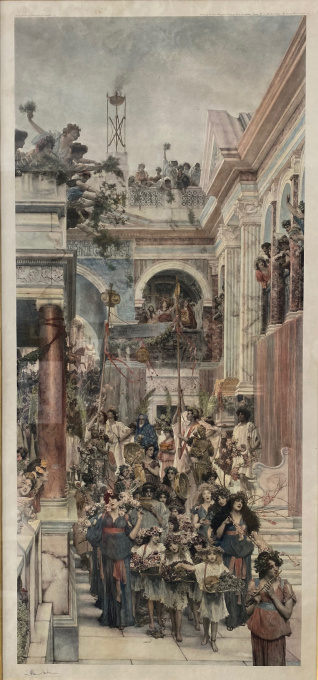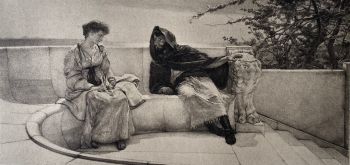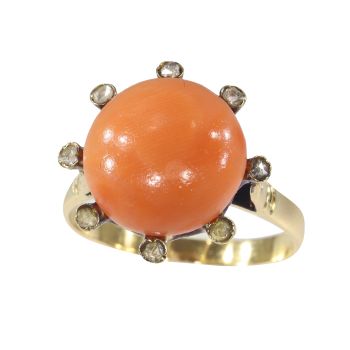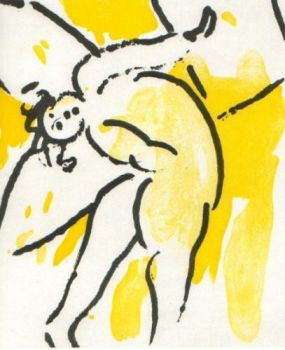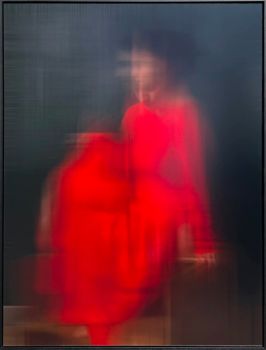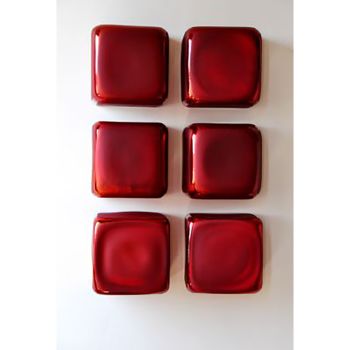"Spring" (original photogravure/ print, signed and hand coloured) 1894
Lawrence Alma-Tadema
HeliographyFine Art paper printPhoto lithoPhotographic print
89 ⨯ 39 cm
Price on request
Gallerease Selected
- About the artwork
"Spring", engraving/ heliogravure / photogravure/ print) made in 1894 by the Berlin Photographic Co. after the painting (Opus CCCXXIV) by Sir Lawrence Alma-Tadema. Handsigned by Alma-Tadema in pencil lower left. Coloured by hand in the same period. Dimensions: 89 x 39.5 cm. In original Victorian frame. Spring is thought to revolve around a procession during the Floralia, a flower festival held in the early Roman Empire from April 28 to 3 May. During the festival, Flora, the goddess of flowers and plants, was central. The painting is one of Alma-Tadema's most famous and ambitious works. The cheerful procession descends from the Palatine Hill. Servants of the Temple of Flora play the tambourine and flute. Behind them, under the canopy, is a bearded priest, with the features of Alma-Tadema herself. Spectators throw flowers abundantly from the roofs of the marble palaces. On the list of the new the engraving is a verse by poet A.C. Swinburne: In a land of bright colors and stories, In a region of shadowless hours, Where the earth has a garment of glory, And a murmur of musical flowers. The work's setting is fictional, bringing together architectural details from a wide variety of sources, including the Pompeii mural in the balcony at the top of the stairs and the frieze of warring centaurs from the temple of Apollo at Bassae on the building to the left. Halfway through the procession, two statues of Satyrs are carried, with a basket of fruit in their hand and Dionysos as a child on their shoulder as a personification of the growing power of the earth. Spring Alma-Tadema was awarded the Grand Prix for the painting at the World Exhibition in Paris in 1900. The work was highly praised by critics at the time, and today it is one of the J. Paul Getty Museum's best-loved paintings. The painting's first owner, Robert Mendelssohn-Bartholdy from Berlin, lent the work to Empress Friedrich (the wife of the late Emperor Friedrich III of Germany), who hung it in her bedroom to recover after an illness. One reviewer wrote: "[The painting] not only appeals to the viewer's sense of beauty, it also makes him look at it positively."
- About the artist
Lawrence Alma-Tadema is one of the most highly renowned romantic artists of late 19th century Britain. He was born in the Netherlands as Laurens Tadema, to the family of the town notary. Later, as he tried to make his niche in the art world, he changed the spelling of his first name to the more English “Lawrence,” and included his middle name “Alma” as part of his surname, so he would be listed among the “A’s” in exhibition catalogues.
As a child, it was decided that Alma-Tadema would pursue the career of a lawyer, but he suffered a mental and physical breakdown when he was fifteen years old. He was diagnosed as consumptive, given a short time to live, and thus free to pursue a life of leisure and pleasure. Once left to his own devices, he decided to study art, as his mother had paid for art lessons in his earlier childhood and it was one of his interests. He regained his health and studied at the Royal Academy of Antwerp in 1852, where he won several respected awards. His first major work was exhibited in 1858, and it won much critical praise, and creating a sensation in the art world. By 1862, he set own in his own studio to pursue his individual career in art.
In 1869, Alma-Tadema lost his wife of six years to smallpox. Disconsolate and depressed, he ceased painting and his health was failing. Under the advice of his physician, he traveled to England for a medical diagnosis, where he was invited to the house of a fellow painter, Ford Madox Brown. It was here that he laid eyes on Laura Theresa Epps, who was 17 at the time, and fell madly in love with her. Alma-Tadema took advantage of the outbreak of the Franco-Prussian war to relocate to England, where he wasted no time contacting Laura and contracting her in private art lessons. It was during one of these lessons that Alma-Tadema proposed, and they were married shortly thereafter. Alma-Tadema was 34 years old, and the bride 18.
Alma-Tadema spent the next part of his life traveling through Europe, and enjoying the continued success of his paintings. As a man, his bursts of bad temper were eased by his extroverted, warm personality and sense of mischief. A perfectionist and obsessive worker, he also innovated a new numbering technique, which made it difficult for forgers to pass off unoriginal works. In his later years, although his artistic output decreased somewhat, he enjoyed continued success, eventually becoming one of the wealthiest painters of the 19th century. He was knighted in England in 1899.
In 1912, Alma-Tadema traveled to Germany to undergo treatment for stomach ulcer, and died in Germany at the age of 76. After his death, his work was mostly ignored. Due to the drastic changes taking place in art, Alma-Tadema’s artistic genius would not come into the public eye again until the 1960s. His meticulous work had since been used as source material for dozens of Hollywood movies.
Are you interested in buying this artwork?
Artwork details
Related artworks
- 1 - 4 / 12
Unknown artist
18th Century Diamond Bracelet with 2000-year-old Intaglios1790
€ 23.000Adin Fine Antique Jewellery
 Curated by
Curated byDanny Bree
1 - 4 / 24- 1 - 4 / 24
Lawrence Alma-Tadema
"Caracalla and Geta: Bear Fight in The Coliseum, AD 203" 1907
Price on requestGallerease Selected
 Curated by
Curated byDanny Bree
1 - 4 / 24- 1 - 4 / 24
- 1 - 4 / 12


